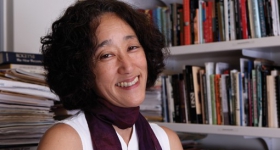GROWING UP IN suburban Ohio in the 1980s and 90s, the Holy Grail for most Asian kids I knew was a combined six-year undergraduate and medical school program offered at a consortium of schools east of Cleveland. Sure, Stanford and Yale were more prestigious, but at fabulous Kent State, you could be a doctor by 23.
I suppose it was a natural progression. We all know about the professional brain drain that plucked a hungry generation from the Motherland and put them to work in hospitals across America. What else would their children do but follow in their footsteps?
But the competitiveness of the medical field was turning most Asian American kids I knew into robots who lived only for high test scores. Those that couldn't get into school in America bought their way into schools in the Caribbean.
But a new crop of books by Asian American and Asian Canadian doctors is giving me hope for these professionals. In the past year, doctor-journalists like Atul Gawande, longtime contributor to The New Yorker and author of Better and Complications, and Sandeep Jauhar, New York Times writer and author of Intern: A Doctor's Initiation, have become the poster children for what seems to be a renaissance for the field of medical narrative. Meanwhile, Dr. Vincent Lam's short-story collection, Bloodletting and Miraculous Cures, won the prestigious Scotiabank Giller Prize in 2006 and was short-listed for the Story Prize this year.
The first Indian American doctor-writer that I remember getting acclaim was Dr. Abraham Verghese, whose brilliant 1995 book, My Own Country: A Doctor's Story, chronicled the AIDS epidemic in small-town Tennessee-mixed in with Verghese's own story of multiple migrations. Born in Ethiopia, Verghese trained in both India and the United States, but it wasn't until he was working in Iowa that Verghese began seriously writing. He attended the Iowa Writers' Workshop.
"Had I grown up in this country, I would have taken up writing as a career-maybe been a journalist," Verghese says in an elegantly accented voice from his office at the Stanford University School of Medicine. "Growing up in Africa, with middle-class Indian parents, I didn't know you could do that. It was doctor, lawyer or failure."
Verghese says that he wasn't forced into becoming a doctor, admitting that he loves the art and science of medicine, but he realized "there is no reason to not also write a bit."
When he started writing, the field of medical narrative was much smaller-with Oliver Sachs and Richard Selzer being some of the only doctors "doing it well." Verghese says there is an inherent connection between the art of storytelling and that of being a doctor. "You see a patient, and you take a history. What is a history but a story?" he says. "There are a lot of parallels, especially with internal medicine because there are so many details. I heard the quote 'God is in the details' in medicine and at Iowa."
While he doesn't know if the phenomenon of Asian American doctor-writers has anything particular to do with the identity of these doctors or just because there are so many Asian American doctors to begin with, he says, "In either case, it is a welcome phenomenon."
Gawande, a general surgeon at the Brigham and Women's Hospital in Boston, had been honing his writing skills as a medical resident for Slate Magazine and then for The New Yorker for years. His books dig into the mysteries of medicine and aim to explain the field to laymen but also to make health care better. Through his personal reporting-on every thing from hand-washing techniques to cystic fibrosis treatment-the reader gets real insight into the medical field.
Jauhar, on the other hand-the director of the Heart Failure Program at the Long Island Jewish Medical Center-gets a little mired in trying to explain the grave choice of becoming a doctor in Intern. Jauhar had been a doctoral student in physics at University of California, Berkeley, only to switch to medicine on a whim. So the book's straight-forward explorations of life as a resident in New York City are sometimes marred by pithy nostalgic passages like this: "A Neil Young song came on the radio, and for a few minutes, I was transported back to parties in the Berkeley Hills, where beer and joints were passed around liberally from one friendship-braceleted hand to the next."
Although the majority of doctor-writers seem to prefer nonfiction, Lam, like Verghese, is more drawn to fiction. The Toronto emergency room doctor has said that he went into medical school to "find material" for his stories, but then stuck around. His first book, Bloodletting and Other Miraculous Cures, follows a medley of characters through medical school and residency into their professional lives.
Verghese, too, has turned back to fiction and Knopf will release his first novel, Cutting for Stone, in 2009. He describes the book as an epic that "begins with a nun giving birth to twins in a hospital in Africa."
Lam told the Montreal Gazette that writing is much harder than medicine because it demands hours of introspective work, "slogging and beating my fists against the page until suddenly something works."
Not exactly something you can do in an operating room.
Neelanjana Banerjee would have made an excellent cardiologist. She is Hyphen's managing editor.









Comments